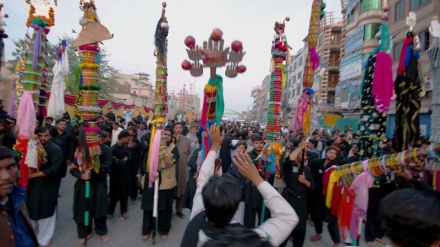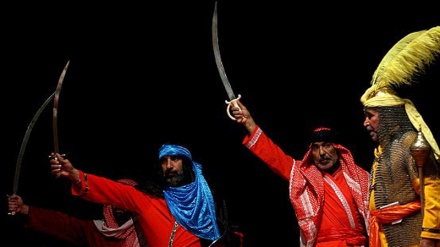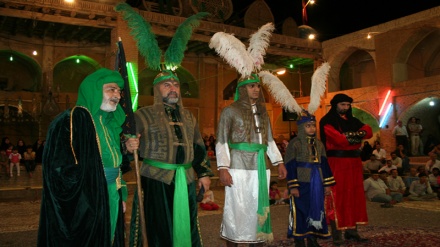Muharram mourning traditions in different lands - 18
Welcome to the 18th part of the 40-plus episodes of a new and interesting series titled “Muharram Mourning Traditions in Different Lands” that we started broadcasting as of October 15 on a daily basis, to commemorate the heartrending tragedy of Karbala, and the martyrdom of Imam Husain (PBUH), the grandson of Prophet Mohammad (Blessings of God upon him and his progeny).
In this series, which delves into the various mourning traditions associated with the Immortal Epic of Ashura in various lands, we look at the history of mourning for Imam Husain (PBUH).
Commemoration of the tragedy of Karbala reached its apogee in the mid-nineteenth century. By then it had spread across a vast area, extending from the Middle East and the Caucasus eastwards to India, Indonesia, and Thailand, and it had even been established in Trinidad by Indian Muslim migrants. In Iran, the memory of Karbala came to permeate social and cultural life, with mourning assemblies and dramatic performances being organized throughout the year, not only in Muharram. The occasion might be furnished by the death of a revered person or the need to fulfill a vow. Gatherings known as sofra (lit. tablecloth), in which the preparation and serving of food played a focal role, were exclusively feminine: the preachers as well as the mourners were all women, and the lives and tribulations of the blessed ladies of the Prophet’s household, such as Hazrat Zainab (peace upon her) were the principal topic of commemoration.
Meanwhile, in India, where many Karbala-related rituals have been part and parcel of local customs for the last 500 years, there is no theatrical representation of the Ta’zia or enactment of the tragedy of Karbala, as in Iran. In India, Ta’zia refers to the interpretive, imaginary representation of the tomb of Imam Husain (AS) that is carried in procession. Tradition has it that the Central Asia conqueror Timur constructed the first Ta’zia of Imam Husain (AS) as an expression of devotion and brought it along on military campaigns. Since then, additional creative representations of the shrines of Karbala have been built for the annual Muharram observances around the world. The size and shape of the Ta’zia vary greatly from small cenotaph-like structures built of papier-mache, tinsel, colored paper, and bamboo to huge constructions that must be wheeled or carried by many people. The onlookers are moved to tears and bouts of chest-beating on seeing he replica of the shrine of Imam Husain (AS).
In the Caribbean islands, the cultural symbols brought by Indian migrant workers, made the Muharram ritual to eclipse all others. Despite the fact that the majority of Indians who migrated to the Caribbean Basin were Hindu rather than Muslim, the Muharram mourning ceremonies for Imam Husain (AS), came to be known as “Hosay”, and became symbols of unity for them. These rituals were often open acts of defiance by the indentured immigrants against British colonial rule. Ta’zia continues to this day as a set of rites identifying the Indians of Trinidad with the homeland of India.
The migration of Indian Muslims to East Africa meant the spread of the mourning ceremonies of Muharram in that part of the world. As workers and businessmen from the Subcontinent put their roots in what are now the countries of Somalia, Uganda, Kenya, Tanzania, and Zanzibar, the devotion for the Martyrs of Karbala became part and parcel of African Muslim culture. Following the triumph of the Islamic Revolution in Iran and its liberating message, more and more people throughout the world were attracted towards the path of the Immortal Martyr of Karbala. Today, Tanzania, especially the capital city of Dar es-Salaam has over twenty Husseiniyahs or Imambaras, where people of various nationalities including Asians and Africans gather to mourn the Prophet’s grandson, Imam Husain (AS). Another important city for the commemoration of Muharram in Tanzania is Arusha in the north.
These ceremonies for the month of Muharram were carried to the Southern African countries, particularly communities of Indo-Pakistan origin, who have popularized commemoration of the tragic martyrdom of the grandson of Prophet Mohammad (blessings of God upon him and his progeny). The black African people, long enslaved by the White Europeans, discovered the path to freedom through the path blazed out by Imam Husain (AS). Off the east African coast, islands of Madagascar, Mauritius, Reunion, the Comoros, etc., soon became centres of Muslims marking the massacre of Ashura, particularly when students from these countries came to Iran for Islamic studies at the prestigious Islamic seminary of holy Qom.
Meanwhile, in West Africa, it were Lebanese traders, who carried the message of Karbala to the people of Ghana, Sierra Leone, Gambia, Nigeria, Ivory Coast and other countries. The impact of the message of Karbala was electrifying on the Muslims of Nigeria, especially after the victory of the Islamic Revolution in Iran in 1979 under the leadership of Imam Khomeini (God bless him). A generation of enlightened preachers in Nigeria, led by Sheikh Ibraheem Zakzaky, spread the message of Karbala far and wide, to the extent that over the years more than ten million people became adherents of Imam Husain (AS). The grand mourning ceremonies that became a regular feature, in particular in the city of Zaria, where the Baqiatollah Islamic centre was built, attracted worldwide attention. Unfortunately, the Nigerian government, on the orders of the Americans, the Zionists, and the Wahhabis of Saudi Arabia, attacked a peaceful gathering of Nigerian Shi’a Muslims on 15 December last year, martyring over 2,000 men, women and children.
MD/AS/ME


